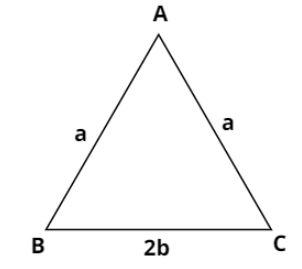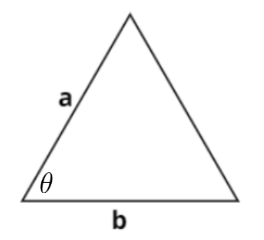
Using Heron’s formula, find the area of an isosceles triangle, the measure of one of its equal sides being $a$ units and the third $2b$ units.
(A) $b\sqrt {{a^2} - {b^2}} $ sq.units.
(B) $a\sqrt {{a^2} + {b^2}} $ sq.units.
(C) $a\sqrt {{a^2} - {b^2}} $ sq.units.
(D) $b\sqrt {{a^2} + {b^2}} $ sq.units.
Answer
555k+ views
Hint: Heron’s formula to determine the area of a triangle is $A = \sqrt {s\left( {s - a} \right)\left( {s - b} \right)\left( {s - c} \right)} $, where $a,{\text{ }}b{\text{ and }}c$ are the sides of the triangle and $s$ is its semi-perimeter. Use this formula for the given isosceles triangle to determine the answer.
Complete step-by-step solution:
According to the question, an isosceles triangle is given such that the length of its equal sides is $a$ units and the length of the third side is $2b$ units. This is shown in the below figure:

We know that Heron’s formula to determine the area of a triangle is $A = \sqrt {s\left( {s - a} \right)\left( {s - b} \right)\left( {s - c} \right)} $, where $a,{\text{ }}b{\text{ and }}c$ are the sides of the triangle and $s$ is its semi-perimeter. The value of the semi-perimeter of the above triangle is:
$
\Rightarrow s = \dfrac{{a + a + 2b}}{2} \\
\Rightarrow s = \dfrac{{2\left( {a + b} \right)}}{2} \\
\Rightarrow s = a + b
$
Putting the values of semi-perimeter and the lengths of sides of the triangle in Heron’s formula, we’ll get:
$
\Rightarrow A = \sqrt {\left( {a + b} \right)\left( {a + b - 2b} \right)\left( {a + b - a} \right)\left( {a + b - a} \right)} \\
\Rightarrow A = \sqrt {\left( {a + b} \right)\left( {a - b} \right) \cdot b \cdot b}
$
We know that $\left( {a + b} \right)\left( {a - b} \right) = {a^2} - {b^2}$. Using this formula, we’ll get:
$
\Rightarrow A = \sqrt {{b^2}\left( {{a^2} - {b^2}} \right)} \\
\Rightarrow A = b\sqrt {\left( {{a^2} - {b^2}} \right)}
$
Thus the area of the given isosceles triangle is $b\sqrt {\left( {{a^2} - {b^2}} \right)} $ sq.units.
(A) is the correct option.
Note: The general formula for finding the area of a triangle is given as:
$ \Rightarrow A = \dfrac{1}{2} \times {\text{base}} \times {\text{height}}$
If $a$ and $b$ are the lengths of two sides of a triangle and $\theta $ is the angle between them as shown in the below figure, the area of the triangle is:

$ \Rightarrow A = \dfrac{1}{2} \times a \times b\sin \theta $
Complete step-by-step solution:
According to the question, an isosceles triangle is given such that the length of its equal sides is $a$ units and the length of the third side is $2b$ units. This is shown in the below figure:

We know that Heron’s formula to determine the area of a triangle is $A = \sqrt {s\left( {s - a} \right)\left( {s - b} \right)\left( {s - c} \right)} $, where $a,{\text{ }}b{\text{ and }}c$ are the sides of the triangle and $s$ is its semi-perimeter. The value of the semi-perimeter of the above triangle is:
$
\Rightarrow s = \dfrac{{a + a + 2b}}{2} \\
\Rightarrow s = \dfrac{{2\left( {a + b} \right)}}{2} \\
\Rightarrow s = a + b
$
Putting the values of semi-perimeter and the lengths of sides of the triangle in Heron’s formula, we’ll get:
$
\Rightarrow A = \sqrt {\left( {a + b} \right)\left( {a + b - 2b} \right)\left( {a + b - a} \right)\left( {a + b - a} \right)} \\
\Rightarrow A = \sqrt {\left( {a + b} \right)\left( {a - b} \right) \cdot b \cdot b}
$
We know that $\left( {a + b} \right)\left( {a - b} \right) = {a^2} - {b^2}$. Using this formula, we’ll get:
$
\Rightarrow A = \sqrt {{b^2}\left( {{a^2} - {b^2}} \right)} \\
\Rightarrow A = b\sqrt {\left( {{a^2} - {b^2}} \right)}
$
Thus the area of the given isosceles triangle is $b\sqrt {\left( {{a^2} - {b^2}} \right)} $ sq.units.
(A) is the correct option.
Note: The general formula for finding the area of a triangle is given as:
$ \Rightarrow A = \dfrac{1}{2} \times {\text{base}} \times {\text{height}}$
If $a$ and $b$ are the lengths of two sides of a triangle and $\theta $ is the angle between them as shown in the below figure, the area of the triangle is:

$ \Rightarrow A = \dfrac{1}{2} \times a \times b\sin \theta $
Recently Updated Pages
Master Class 9 Social Science: Engaging Questions & Answers for Success

Master Class 9 Science: Engaging Questions & Answers for Success

Master Class 9 English: Engaging Questions & Answers for Success

Master Class 9 Maths: Engaging Questions & Answers for Success

Master Class 9 General Knowledge: Engaging Questions & Answers for Success

Class 9 Question and Answer - Your Ultimate Solutions Guide

Trending doubts
Which places in India experience sunrise first and class 9 social science CBSE

Fill the blanks with the suitable prepositions 1 The class 9 english CBSE

Write the 6 fundamental rights of India and explain in detail

Difference Between Plant Cell and Animal Cell

What is pollution? How many types of pollution? Define it

What is the Full Form of ISI and RAW




